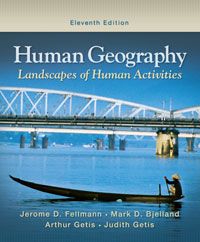1 A) commercial B) industrial C) residential D) transportation 2 A) North America B) Europe C) Latin America D) East Asia 3 A) women are more numerous in large central cities than are men. B) women constitute the bulk of the urban poor because "women's jobs" are dominated by lower wage rates, part-time employment, and lack of job security. C) women rely more heavily on public transportation than do men. D) women tend to find employment in occupations that are more geographically concentrated than men's occupations. 4 A) It is based on the city's fertility rates. B) It is only useful in larger metropolitan centers. C) It only increases; it does not decrease. D) The size of the effect is determined by the city's basic/nonbasic ratio. 5 A) few of the large cities have modern centers of commerce. B) all have experienced massive in-migrations from rural areas. C) most are ringed by vast squatter settlements. D) all have populations greater than their formal functions and employment bases can support. 6 A) are located in the center of a rural area. B) developed on an isotropic plain. C) serve as nodal points for the distribution of goods and services to surrounding nonurban areas. D) were first described by Walter Christaller. 7 urban area?A) A place in the United States with 2,500 or more inhabitants. B) A place in Greece with at least 10,000 inhabitants. C) A place in Nicaragua with 1,000 or more inhabitants. D) All of the above. 8 A) 1/3 B) 1/100 C) 1/1000 D) 3/1 9 A) government policies leading to a shortage of affordable housing B) increases in soup kitchens, food banks, and shelters run by nonprofit groups C) increases in job loss, divorce, domestic violence, and incapacitating illnesses D) reduced funding for mental hospitals, resulting in more formerly institutionalized people out on the street 10 A) It is designed to minimize land use incompatibilities. B) It is designed to segregate different populations from each other. C) It is designed to prevent the emergence of slums. D) It is designed to reduce market-induced pressures for land use change. 11 A) communities become self-contained. B) houses become dispersed along main roads. C) the heights of buildings increase. D) trade develops between two or more settlements. 12 A) Africa B) Australia C) Russia D) North America 13 A) buying and renovating properties B) spending money in local businesses C) establishing new businesses D) All of the above 14 A) 4,000 B) 10,000 C) 25,000 D) 35,000 15 A) sprawling suburbs and exurbs B) compact city form C) low population densities D) All of the above 16 A) have fewer large and complex cities than small towns. B) have small towns that serve as hubs for high order economic functions. C) many megalopolises. D) the same number of small towns and megacities. 17 A) 280. B) 300. C) 340. D) 420. 18 A) Chicago is approximately 850 miles from New York City. B) Des Moines, Iowa, is located in the heart of the Corn Belt. C) Pittsburgh is located at the confluence of the Ohio, Allegheny, and Monongahela Rivers. D) Seattle is located in the Pacific Northwest. 19 A) city B) metropolitan area C) town D) urbanized area 20 A) Egypt. B) Nairobi. C) South Korea. D) United States. 21 A) number of apartment buildings. B) downtown gentrification. C) ethnic enclaves. D) transportation networks. 22 A) South and West. B) Northwest and Northeast. C) Midwest and Northeast. D) Southeast and Midwest. 23 A) commuting distance to the CBD. B) ethnic composition. C) number of mass transit versus automobile users. D) number of persons per room per housing unit. 24 A) Latin American city B) East European city C) North American city D) West European city 25 A) Western Europe B) South Asia C) Africa D) Latin America





